| Article ID | Journal | Published Year | Pages | File Type |
|---|---|---|---|---|
| 1309314 | Inorganica Chimica Acta | 2010 | 8 Pages |
Rhodium(III) complexes of 1,2-naphthoquinone-1-oxime (1-nqo) [Rh(1-nqo)L2Cl2] 1–3 [1, L = 4-methylpyridine (mpy); 2, L = 4-phenylpyridine (ppy); 3, L = 4-acetylpyridine (apy)] were prepared. The structure of complex 1 is analyzed by single crystal X-ray crystallography. All of the complexes were characterized by mass spectrometry, 1H–1H COSY NMR and FT-IR. UV–Vis absorption spectroscopy and cyclic voltammetry were employed to investigate the electronic transition behaviors of the complexes. The complexes displayed irreversible metal-localized two-electron reductions from RhIII to RhI on the cyclic voltammogram. While the low-energy absorptions at λmax of 488–490 nm on the UV–Vis spectra of the complexes were related to metal to 1-nqo ligand charge transfer [MLCT, dπ(Rh) → π∗(1-nqo)] and chloride to 1-nqo ligand charge transfer [LLCT, pπ(Cl) → π∗(1-nqo)] based on the theoretical calculations using time-dependent density functional theory (TD-DFT).
Graphical abstractRhodium(III) complexes of 1,2-naphthoquinone-1-oxime (1-nqo) [Rh(1-nqo)L2Cl2] 1–3 (L = 4-methylpyridine, 4-phenylpyridine and 4-acetylpyridine, respectively) were synthesized and characterized by FAB MS, 1H–1H COSY NMR, FT-IR, as well as single crystal X-ray crystallography for complex 1. The electron transfer properties of the complexes were studied by electronic absorption spectroscopy and electrochemistry, as well as theory calculations using density functional theory (DFT).Figure optionsDownload full-size imageDownload as PowerPoint slide
